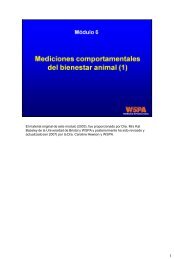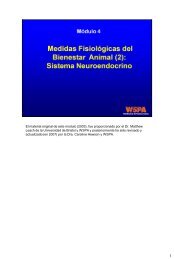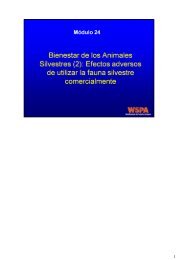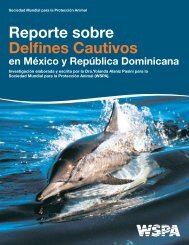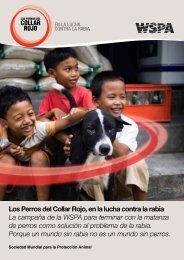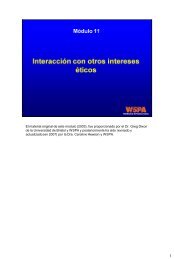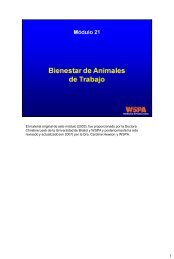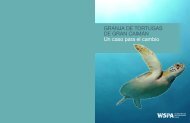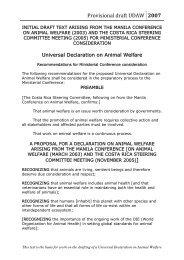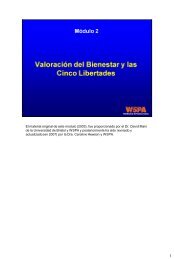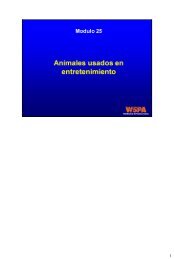Animales en investigación - Sociedad Mundial para la Protección ...
Animales en investigación - Sociedad Mundial para la Protección ...
Animales en investigación - Sociedad Mundial para la Protección ...
- No tags were found...
You also want an ePaper? Increase the reach of your titles
YUMPU automatically turns print PDFs into web optimized ePapers that Google loves.
Cerca del 10% de todos los animales de <strong>la</strong>boratorio son usados <strong>para</strong> toxicología yotras evaluaciones de seguridad (Cifras de <strong>la</strong> Unión Europea 2002 1 ). Losproductos probados pued<strong>en</strong> ser químicos <strong>para</strong> el hogar, farmacéuticos ycosméticos. Las <strong>en</strong>tidades gubernam<strong>en</strong>tales de regu<strong>la</strong>ción, requier<strong>en</strong> pruebas de“seguridad” estándar, <strong>para</strong> que sean desarrol<strong>la</strong>das antes que los productos <strong>en</strong>tr<strong>en</strong><strong>en</strong> el mercado listos <strong>para</strong> el uso. Muchas de esas pruebas son, por conv<strong>en</strong>ción,realizadas <strong>en</strong> animales y deb<strong>en</strong> incluir:• Pruebas de toxicidad aguda (efectos de grandes dosis of productos) y pruebas detoxicidad crónica (efectos de pequeñas dosis por <strong>la</strong>rgos períodos)• Pruebas de irritabilidad <strong>en</strong> ojos y piel, por ejemplo, <strong>la</strong> prueba de Draize involucrael goteo de sustancias <strong>en</strong> los ojos de los conejos (ver sigui<strong>en</strong>te diapositiva)• Pruebas de car Carcinog<strong>en</strong>icity tests to see if the product will cause cancer•Developm<strong>en</strong>tal and reproductive toxicity tests to id<strong>en</strong>tify harmful effects onreproductive systems or foetuses•Mutag<strong>en</strong>icity tests to assess whether products can cause g<strong>en</strong>etic mutationsIt is accepted that these tests are not foolproof as an indicator of how a productmight affect people; therefore studies are also performed in healthy humanvolunteers, and also in clinical trials, before drugs are marketed.The testing of chemicals for toxic risks is stipu<strong>la</strong>ted by regu<strong>la</strong>tors. The g<strong>en</strong>eraltesting protocol to assess risk involves hazard characterisation, hazard assessm<strong>en</strong>t,hazard exposure assessm<strong>en</strong>t and risk assessm<strong>en</strong>t. Toxicological profiles of eachchemical are evaluated, ev<strong>en</strong> if it emerges on completion of the tests that thelikelihood of exposure is so low that the minimal toxic dose will not be reached inreal life.A more realistic approach, which would require less testing and thus reduce th<strong>en</strong>umber of animals is to first assess exposure levels (de Boo and H<strong>en</strong>driks<strong>en</strong>,2005 2 ). This is the reversed toxicology approach. Besides the animal welfareimplications, which can be quite severe, many researchers criticise the validity ofthese tests, as the animal data do not seem to be predictive of human health (e.g.Knight et al., 2006 3 ).7



